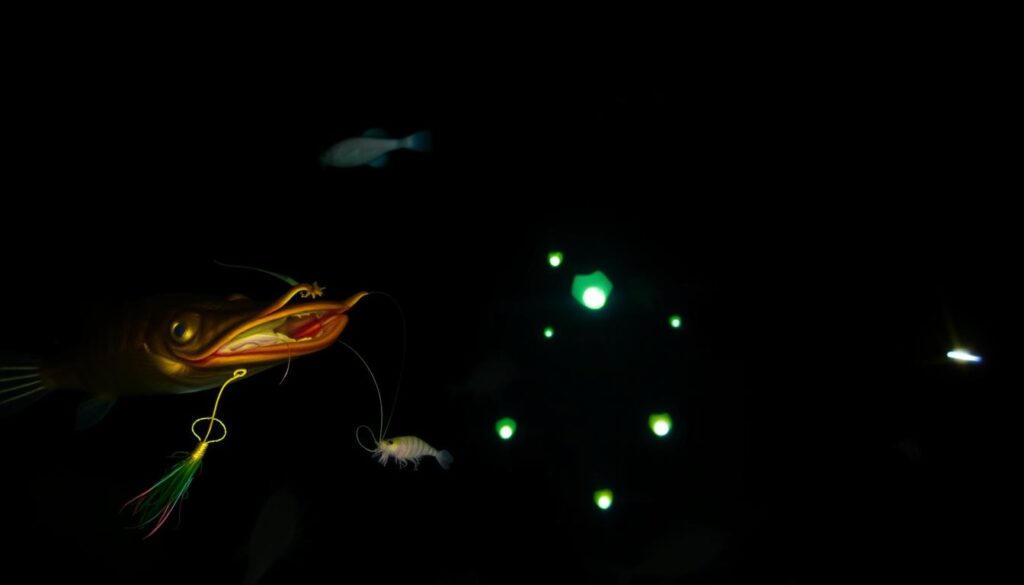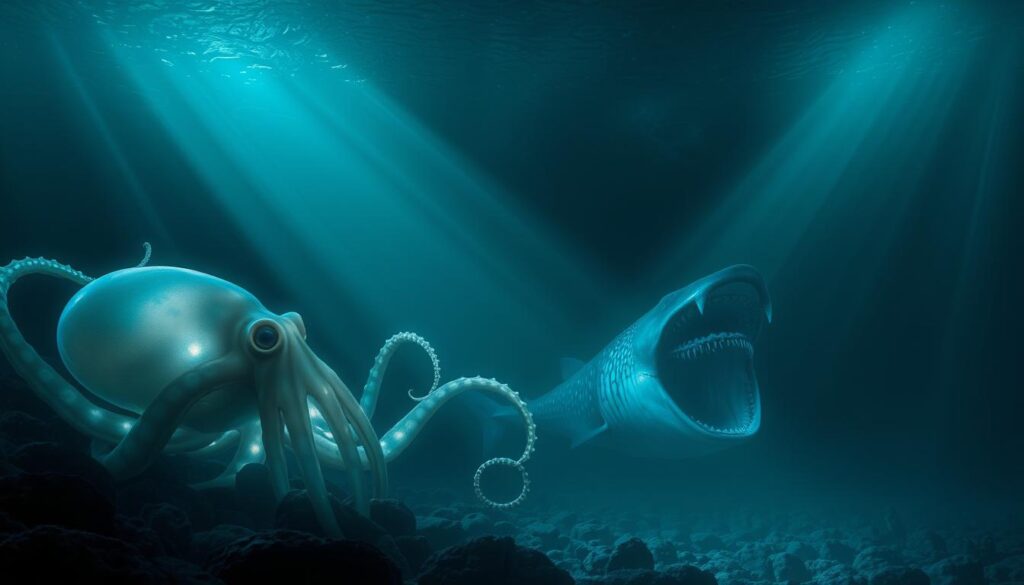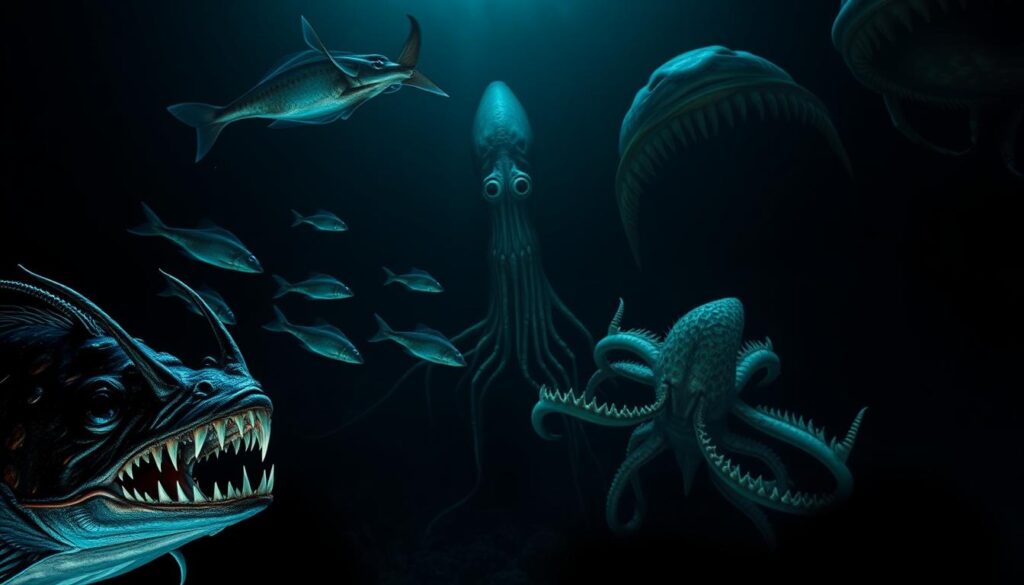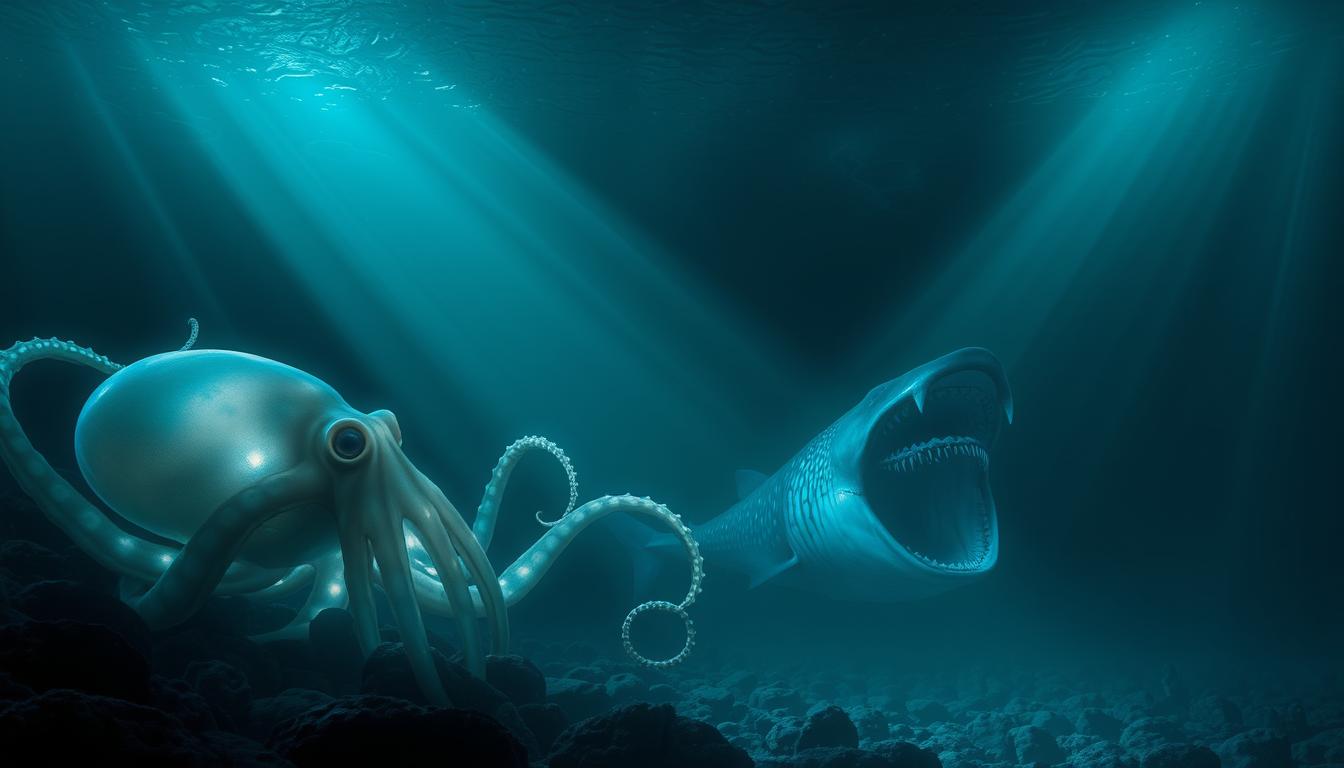The deep sea is vast and full of mysteries. It’s home to strange and fascinating ocean creatures. Creatures like the anglerfish and giant squid have adapted to extreme conditions in unique ways.

Exploring deep-sea life is thrilling. It offers insights into our natural world and the incredible diversity of life on Earth. By learning about these creatures and their habitats, we can appreciate the importance of preserving our oceans.
Key Takeaways
- Deep-sea life is incredibly diverse, with many strange and fascinating creatures.
- Ocean creatures have adapted to extreme conditions in the deep sea in unique ways.
- Exploring deep-sea life can offer insights into the natural world and the importance of preserving our oceans.
- The deep sea is a largely unexplored environment, with much still to be discovered.
- Learning about deep-sea life and ocean creatures can be a thrilling experience.
- Preserving our oceans and the deep-sea life that inhabits them is crucial for the health of our planet.
The Mysterious World of the Deep Ocean Abyss
The deep ocean abyss is a mysterious place. It has extreme conditions that support unique marine life. The deep sea is very pressurized, cold, and dark. Yet, marine life has found ways to survive, like using bioluminescence and having large eyes.
Food is key for life in the deep sea. It’s home to many species, from small fish to giant squid. These creatures have found their own spots in the deep-sea world.
Extreme Conditions of the Deep
The deep sea is a tough place to explore. The pressure is over 1,000 times what we feel at sea level. The temperature is just a few degrees above freezing. Still, scientists use submersibles and other tech to explore it.
Adaptation to Darkness
Many deep-sea creatures can make their own light. This is called bioluminescence. They use it for talking, finding mates, and defending themselves. It’s a beautiful sight in the dark depths.
Discovery Timeline of Deep-Sea Life
People have been finding deep-sea life since the early 1900s. They’ve found deep-sea vents, which support special marine life. Today, scientists keep exploring the deep sea with new tech, finding more species.
What Makes These Strangest Deep-Sea Creatures So Unique
The deep sea is filled with bioluminescent creatures that have adapted to its harsh conditions. They have big eyes and clear bodies to survive. Their ability to make light is used for talking, finding mates, and defending themselves.
Some of the most unique species in the deep sea are anglerfish, giant squid, and deep-sea jellyfish. They live in a world with little light. So, they can make their own light. This light helps them find food and talk to others of their kind.
Here are some key traits of bioluminescent creatures:
- Ability to produce light through chemical reactions
- Use of bioluminescence for communication, mating, and defense
- Large eyes to detect limited light in the deep sea
- Transparent bodies to avoid detection by predators
These unique species are not just interesting to learn about. They are also key to the deep sea’s ecosystem. By studying them, we can understand the deep sea’s complex world better.
The Bioluminescent Masters of the Deep
Deep-sea lighting is rare and fascinating. It’s a key feature of many deep-sea creatures. They can produce light through a chemical reaction involving luciferin and oxygen.
This ability is vital for survival. It helps them communicate, find prey, and defend against predators.
Some creatures use light to lure prey. Others use it to confuse or distract predators. For example, squid have light-producing cells to startle predators with a bright flash.
How Sea Creatures Create Their Own Light
The process of creating light is complex. It involves chemical reactions with luciferin and oxygen. An enzyme called luciferase speeds up this reaction.
This results in a burst of light. It can be used for communication or defense.
The Purpose of Bioluminescence
Bioluminescence has many purposes in the deep sea. It helps with communication, mating, and defense. For instance, some fish use it to attract mates.
Others use it to warn off predators. This adaptation has helped deep-sea creatures thrive in the dark environment.
Giants of the Ocean Depths
The deep-sea giants, like giant squid and deep-sea fish, are truly amazing. They live in the harsh deep sea. These creatures have special traits to survive and even rule their homes.
The giant squid can grow up to 20 feet long. The deep-sea anglerfish has a lure on its head to catch food. These giants are not just big; they’re also key to the deep-sea’s balance.

Some key traits of deep-sea giants include:
- Large size, often exceeding 10 feet in length
- Unique adaptations, such as bioluminescence and powerful jaws
- Ability to survive in extreme conditions, including near-freezing temperatures and intense pressure
These traits help deep-sea giants live in the deep sea. By studying them, we can learn more about this fascinating world.
Transparent Wonders of the Deep
Deep-sea creatures have evolved unique features to survive in the harsh, dark ocean depths. One fascinating feature is transparency. This allows certain species to blend in with their surroundings, making them nearly invisible to predators. This camouflage is crucial for transparent sea creatures to avoid being detected in areas with high levels of predation.
Transparent bodies are achieved through various mechanisms. This includes the lack of pigmentation and the presence of light-scattering molecules. This transparency enables creatures to reflect light and blend in with the surrounding water. It makes it difficult for predators to spot them. Some notable species that exhibit this feature include the transparent sea cucumber and the glass squid, which use camouflage to survive in the deep sea.
Some of the key benefits of transparency for deep-sea creatures include:
- Reduced visibility to predators
- Increased ability to sneak up on prey
- Improved survival rates in areas with high predation
These advantages make transparency a valuable trait fortransparent sea creatures. It allows them to thrive in the deep ocean.
The Most Terrifying Deep-Sea Predators
Deep-sea predators live in the harsh deep ocean. Here, food is rare and competition is tough. They have special ways to survive and hunt in the dark, cold waters. The deep sea is home to terrifying creatures like giant squid, deep-sea fish, and invertebrates.
Anglerfish use a lure on their head to catch prey. Viperfish have big teeth and a glowing lure on their jaw. These creatures show the deep sea’s diversity and complexity. Deep-sea predators are key to the ocean’s balance. Studying them gives us insights into these fascinating creatures.

Ocean predators, like giant squid and colossal squid, are huge. They can grow up to 20 meters long. Their size and survival skills in the deep sea are impressive. Learning about ocean predators helps us understand ocean relationships and human impacts.
Some key traits of deep-sea predators include:
- Bioluminescence: the ability to produce light in the dark depths of the ocean
- Large teeth and powerful jaws: adapted for catching and eating prey in the dark
- Enhanced senses: such as large eyes and sensitive lateral lines, to detect prey in the dark
These traits help deep-sea predators thrive in the harsh deep ocean. They are some of the most fascinating and terrifying creatures on Earth.
Bizarre Feeding Mechanisms in the Deep
Deep-sea creatures have developed unique feeding mechanisms to live in the deep ocean’s harsh conditions. These methods are often strange and captivating. For instance, some use bioluminescent lures to lure in prey. Others have big teeth and strong jaws to catch and eat large prey.
Deep-sea creatures have interesting hunting strategies. Some are fast and agile, catching prey on the run. Others are sneaky, using camouflage to surprise their prey. The gulper eel, for example, can eat fish and other creatures much bigger than itself because of its huge mouth and stretchy stomach.
Extreme Hunting Strategies
- Bioluminescent lures to attract prey
- Large teeth and powerful jaws to capture and eat large prey
- Camouflage and stealth to sneak up on unsuspecting prey
Unique Digestive Adaptations
Deep-sea creatures have special digestive systems to survive in the deep. Some have slow metabolisms, helping them live off little food. Others have unique digestive systems for eating and digesting big prey. The frilled shark, for example, can eat large prey with its long body and sharp teeth. It then digests it slowly over time.
Recently Discovered Deep-Sea Species
The deep sea is vast and mostly unexplored. New discoveries are still being made. Advances in exploration technologies have let scientists explore the deep sea more than ever before.
Modern Exploration Technologies
Key technologies include remotely operated vehicles (ROVs) and autonomous underwater vehicles (AUVs). These vehicles have advanced sensors and cameras. They help scientists collect data and footage from the deep sea.
Breakthrough Findings
Some notable recently discovered species include the giant squid and the deep-sea vent eel. These discoveries have greatly expanded our understanding of the deep sea. Some key findings are:
- The giant squid is one of the largest invertebrates on Earth, with some specimens reaching up to 13 meters in length.
- The deep-sea vent eel is a species of eel that lives in the hot, chemical-rich environments surrounding deep-sea vents.
- Both of these species are found in the deep sea, and are able to survive in environments that would be hostile to most other forms of life.
The Impact of Climate Change on Deep-Sea Life
Climate change is deeply affecting deep-sea life, disrupting the ocean’s ecosystem balance. Rising ocean temperatures and changes in chemistry are altering where and how many deep-sea species live. For example, deep-sea fish are moving to cooler waters, and deep-sea corals are finding it hard to survive in acidic waters.
Ocean conservation is key to fighting climate change’s effects on deep-sea life. By cutting down on greenhouse gases and protecting marine habitats, we can save deep-sea species diversity. Important ocean conservation steps include:
- Creating marine protected areas to protect deep-sea ecosystems
- Using sustainable fishing to lessen bycatch and habitat damage
- Supporting research and monitoring to understand climate change’s deep-sea impacts
By acting on climate change and supporting ocean conservation, we can safeguard deep-sea creatures. It’s vital to keep studying and tracking climate change’s effects on deep-sea life. This knowledge will guide us in protecting our oceans for the future.
How Scientists Study These Elusive Creatures
Deep-sea research is a tough field. It needs special tools and methods to study deep-sea creatures. Scientists have learned a lot about these organisms through their work.
Researchers use many tools for their studies. They have research vessels, ROVs, and AUVs. These vehicles have cameras, sonar, and sampling gear. They help scientists get data and samples from the deep.
Techniques and Technologies
Some important tools in deep-sea research are:
- Remotely operated vehicles (ROVs) for exploring and sampling the seafloor
- Autonomous underwater vehicles (AUVs) for mapping and monitoring the ocean
- Acoustic sensors for tracking and studying marine life
Challenges and Opportunities
Deep-sea research is hard, but scientists keep exploring. They help us understand the ocean’s depths better. Their work shows us the deep sea’s beauty and importance. It encourages us to protect these ecosystems for the future.
If the strangest deep-sea creatures amaze you, then birds that sound like robots are just as fascinating.
Conclusion: Preserving the Ocean’s Most Fascinating Inhabitants
The deep sea is home to strange and unique creatures. These are key parts of a delicate marine ecosystem. To keep these fascinating inhabitants alive, we must focus on conservation efforts and act now to preserve ocean life.
Creating marine protected areas helps keep their homes safe. It also encourages fishing that’s good for the planet. We must also cut down on pollution and tackle climate change to keep the ocean healthy.
By working together, we can learn more about these mysterious beings. We can use new tech and spread the word to help them survive. Let’s protect the deep sea’s wonders for the next generations to enjoy.
FAQ
What are some of the strangest deep-sea creatures?
The deep sea is home to many odd creatures. The anglerfish, giant squid, viperfish, and transparent sea cucumber are just a few examples. They have special features to survive the deep ocean’s harsh conditions.
How do deep-sea creatures adapt to the darkness and high pressure of the deep ocean?
Deep-sea creatures have unique ways to cope with the deep ocean’s darkness and pressure. They use bioluminescence, have big eyes, and move slowly. Bioluminescence helps them communicate, find mates, and defend themselves. Their large eyes help them see in the dim light.
What is the purpose of bioluminescence in deep-sea creatures?
Bioluminescence lets deep-sea creatures produce light. It helps them communicate, find mates, and defend themselves. This light comes from a chemical reaction involving luciferin.
What are some of the largest and most impressive deep-sea creatures?
The deep sea is full of large and impressive creatures. Giant squid, deep-sea fish, and other invertebrates thrive here. They have evolved to survive in the deep sea, where food is scarce.
What are some of the most terrifying deep-sea predators?
The deep sea has some scary predators. The anglerfish uses a lure on its head to catch prey. The viperfish has big teeth and a bioluminescent lure on its jaw. These creatures are highly efficient hunters.
How do deep-sea creatures feed in the extreme conditions of the deep ocean?
Deep-sea creatures have unique ways to eat. They use bioluminescent lures, big teeth, and special digestion. For example, the gulper eel has a huge mouth and a stretchy stomach to eat large prey.
What new deep-sea species have been discovered recently?
New species are being found thanks to better exploration tools. Remotely operated vehicles (ROVs) and autonomous underwater vehicles (AUVs) help scientists explore the deep sea. They’ve found the giant squid and the deep-sea vent eel among others.
How is climate change impacting deep-sea life?
Climate change is affecting deep-sea life. It’s changing ocean temperature, chemistry, and currents. These changes are altering where and how many deep-sea species live, impacting the ecosystem.
What challenges do scientists face when studying deep-sea creatures?
Studying the deep sea is tough. The environment is remote and harsh. Scientists use research vessels, ROVs, and AUVs to study it. But the extreme conditions make this work hard and expensive.
